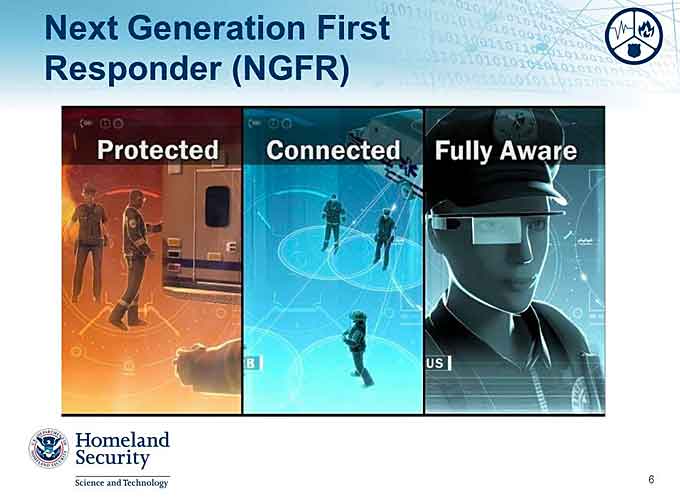
Department of Homeland Security (DHS) Science and Technology Directorate (S&T) wants to evaluate technology solutions for first responders.
S&T has released a Request for Information (RFI) for participation in the Next Generation First Responder (NGFR) – Harris County Operational Experimentation (OpEx).
The OpEx will take place December 3 -7, 2018, at the Port of Houston in Houston, Texas, and will integrate first responder technologies to enhance the mission-response capabilities of Houston-area responders and the U.S. Coast Guard.
The RFI, posted on FedBizOpps, is open to industry, academia, Federally Funded Research and Development (R&D) Centers, government agencies, and other organizations with innovative first responder technology solutions ready for testing and evaluation.
DHS S&T is specifically seeking technologies that provide on-body, incident area, agency-wide or cross-jurisdictional capabilities that make responders better protected, connected and fully aware.
(The Next Generation First Responder (NGFR) Apex Program seeks to help tomorrow’s first responder be more protected, connected and fully aware. Courtesy of DHS Science and Technology Directorate and YouTube)
For the NGFR – Harris County OpEx, the NGFR Apex program will provide participating responders with solutions that use guidelines found in the NGFR Integration Handbook1 to integrate into existing Harris County and City of Houston applications, processes and procedures, without adding to first responders’ workloads.
Responders from the City of Houston, Harris County, Port of Houston and the U.S. Coast Guard will participate in a functional exercise with a HazMat scenario at the port, and will be equipped with integrated systems of DHS-developed and commercial technologies the enhance or provide new capabilities.
DHS S&T is seeking to evaluate technology solutions that provide on-body, incident area, agency-wide, or cross-jurisdictional capabilities that make responders better protected, connected and fully aware.
The Harris County OpEx is focusing on the following capability gaps:
- On-body or handheld sensors (e.g., physiological monitoring, environmental threat detection, indoor location tracking)
- On-body or handheld situational awareness displays or devices (e.g., mapping application that can show responder location and sensor data alerts, heads-up displays) for first responders and/or incident commanders
- On-body devices that manage or intelligently route multiple communications pathways (e.g., Land Mobile Radio, LTE, Wi-Fi, Bluetooth, Satellite, FirstNet) for first responders
- Data analytics services that synthesize data, analyze and present actionable information to first responders and/or incident commanders
- Body-worn power distribution and data connectivity systems
- Indoor mesh networks for Land Mobile Radio, Wi-Fi and LTE devices,
- Interfaces between on-body or handheld sensors and situational awareness tools or computer-aided dispatch (CAD) systems
- Interfaces between disparate CAD systems, and
- Interfaces between CAD systems and collaboration applications
- Indoor responder location system
The deadline for submitting applications is March 30, 2018.
Responses should be focused on 10 key capability gaps identified in the RFI, including sensors, data analytics tools and interfaces with computer-aided dispatch systems.
Solutions must be at Technology Readiness Level 6 or above.
The government does not intend to make a contract award based on this RFI, but will seek to enter a Limited Purpose Cooperative Research and Development Agreement with each manufacturer, vendor or non-public entity selected to participate in the NGFR – Harris County OpEx.

“First responders protect our communities every day, and often do so with no more than a radio and a uniform,” said DHS S&T Program Manager Sridhar Kowdley.
“Commercial technology is advancing at a remarkable pace, and it’s time for public safety to leverage those advancements – but to do that, integration is essential.”
“During this OpEx, we want to prove that diverse responder technologies can be integrated using open standards and that integrated capabilities increase first responder safety and effectiveness.”
During the NGFR – Harris County OpEx, S&T will evaluate how DHS-developed technologies, commercial technologies and legacy public safety systems integrate using open standards, and how those integrated capabilities increase responder safety and efficiency.
DHS S&T will work with FirstNet to assess user experience of priority and preemption capabilities of participating partners.
 The OpEx builds directly upon the success of the 2017 Grant County – DHS S&T NGFR Technology Experiment, which tested the integration of physiological and location sensors, situational awareness systems, drones, datacasting, and deployable communications into a cohesive public safety solution.
The OpEx builds directly upon the success of the 2017 Grant County – DHS S&T NGFR Technology Experiment, which tested the integration of physiological and location sensors, situational awareness systems, drones, datacasting, and deployable communications into a cohesive public safety solution.
For more information on this RFI, the DHS S&T Next Generation First Responder Apex program, or future DHS S&T solicitations, visit https://www.dhs.gov/NGFR or contact NGFR@hq.dhs.gov.

















